ISLAMABAD (Big Digit) NDMA relief operations in Khyber Pakhtunkhwa on the instructions of the Prime Minister
ISLAMABAD (Big Digit) The Prime Minister has directed the Chairman NDMA to intensify relief operations in Khyber Pakhtunkhwa. While the Pakistan Army is carrying out relief operations in the flood-affected areas of Khyber Pakhtunkhwa, Prime Minister Shahbaz Sharif has directed the Chairman National Disaster Management Authority (NDMA) to intensify relief operations in the 9 affected districts of Khyber Pakhtunkhwa. On the social networking platform ‘X’, Prime Minister Shahbaz Sharif said that he is deeply saddened by the devastation caused by cloudburst and flash floods in Khyber Pakhtunkhwa and northern Pakistan. We stand in solidarity with our brothers and sisters in this hour of grief, the government is mobilizing all resources for rescue and relief operations. The Prime Minister said that in a meeting with the Chairman NDMA, he has directed that relief operations be intensified in the affected districts of Swat, Buner, Bajaur, Torghar, Mansehra, Shangla and Battagram, and immediate attention be paid to Bajaur and Battagram. He said that immediate relief is being provided to the stranded residents, medical assistance is being provided to the injured and heavy machinery has been deployed to clear the roads and restore connectivity. It should be noted that the flood situation caused by cloudburst in various districts of Khyber Pakhtunkhwa has caused havoc,
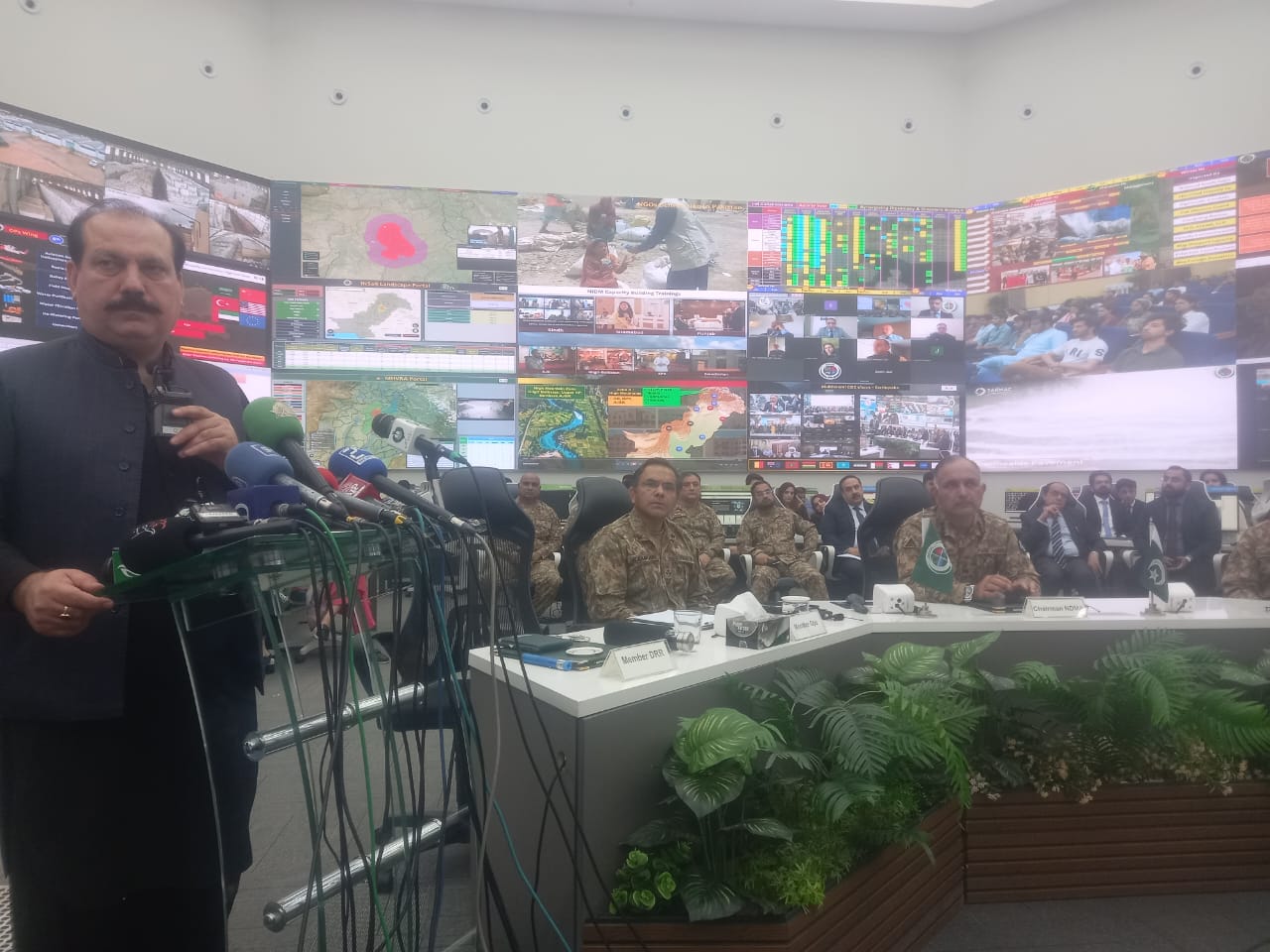
In an emergency review meeting chaired by Prime Minister Shehbaz Sharif, the Chairman National Disaster Management Authority (NDMA) gave a briefing on the losses due to rains and floods in Khyber Pakhtunkhwa and Gilgit-Baltistan. The Prime Minister directed the NDMA to continue its cooperation with the Khyber Pakhtunkhwa government and said that all resources should be utilized for the rescue and relief operation. Rescue operations are underway in different areas of Buner by the Pakistan Army, military forces are also participating in rescue operations in village Churak. People buried under the rubble of destroyed houses in Adam Khel are also being rescued. The supply of ration and beds to the affected families is also ongoing, the Pakistan Army is playing its full role to help the people in the flood-affected districts. Despite the bad weather, Pakistan Army helicopters are participating in rescue and relief activities, citizens expressed satisfaction with the relief work and thanked the Pakistan Army. Meanwhile, on the instructions of the Prime Minister of Pakistan, the Chairman NDMA briefed the national and international media about the rescue and relief operations in the affected areas. Meanwhile, on the instructions of the Prime Minister of Pakistan, the Chairman NDMA briefed the national and international media about the rescue and relief operations in the affected areas. During a media briefing at the NDMA headquarters regarding the recent rains and floods and relief activities, at the beginning of the media briefing question by senior Pakistani journalist Asghar Ali Mubarak the Chairman of the National Disaster Management Authority (NDMA), Lieutenant General Inam Haider Malik, said that climate change has severely affected Pakistan, the restoration of communication infrastructure, roads and bridges will be among the top priorities, due to climate change, it is getting more intense every year compared to the previous year, which we will fight together as a nation, after the end of monsoon relief activities, we will work with the Ministry of Communications, Housing and other institutions to ensure the restoration of housing and infrastructure, advance information will be provided to citizens through an awareness campaign, advance measures will be taken to minimize the losses caused by the monsoon.
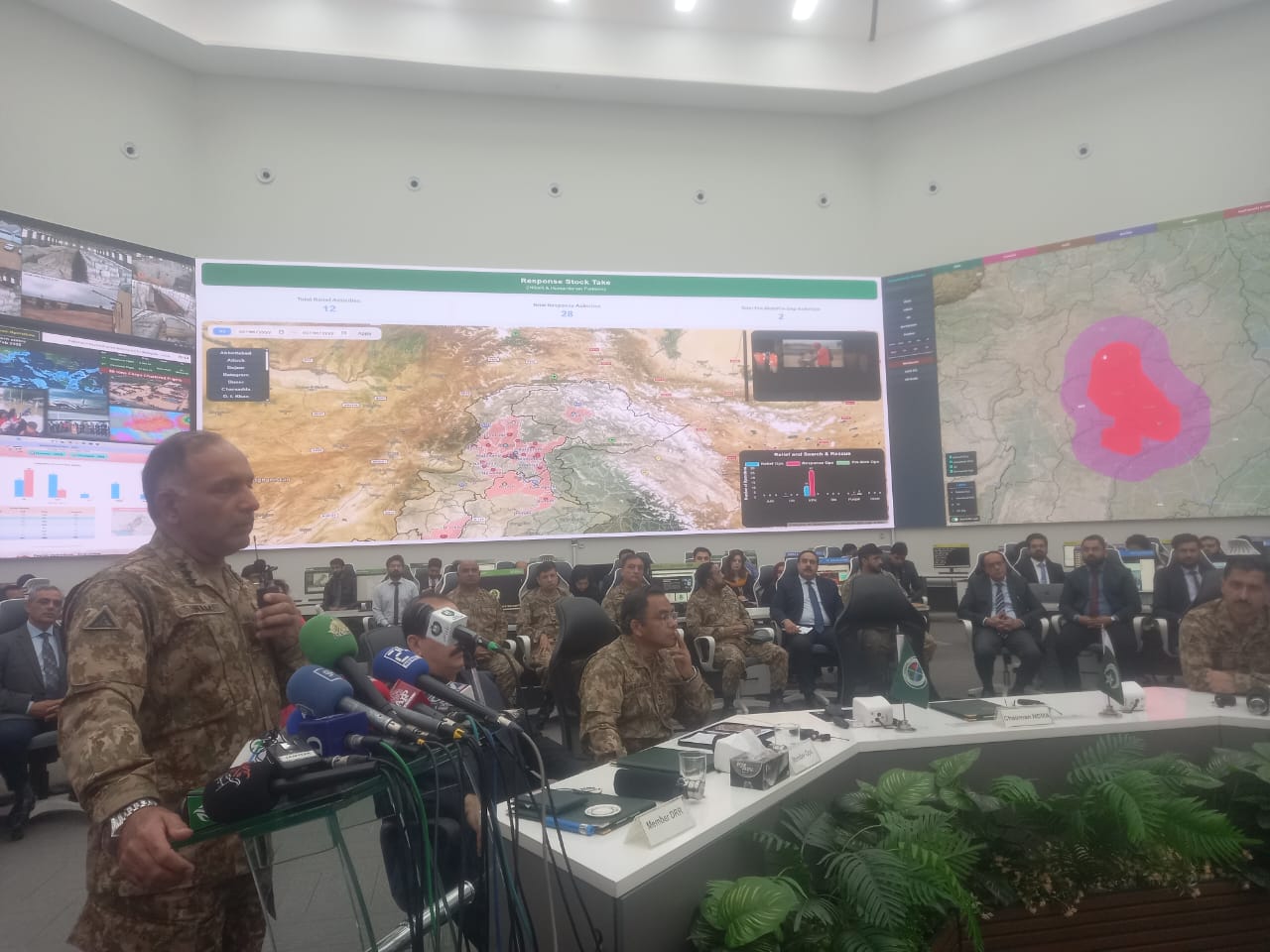 The purpose of the NDMA briefing is to provide information about the relief and rehabilitation efforts being carried out at the national level. It is to inform you that special measures are being taken in Khyber Pakhtunkhwa for the past one week. He said that this year the intensity of heat has been high due to which the spread and intensity of monsoon 2025 is also high. This year, the monsoon rains have increased by 50 to 60 percent compared to last year, due to which after the flash floods and accidents in Gilgit-Baltistan last month, Khyber Pakhtunkhwa has been facing floods and flash flooding accidents for the past few days. He expressed the expectation that two to three more monsoon showers will enter Pakistan in the coming days, which will continue until the first 10 days of September. The Government of Pakistan, the Armed Forces and all other institutions equally share the grief of the victims in relation to the losses caused by rain and floods. He expressed the determination that we, along with the provincial government, will conduct a complete survey of the areas as per the instructions of the Prime Minister and efforts will be made to fully rehabilitate the victims. Similarly, the restoration of communication infrastructure, roads and bridges will be among the top priorities. The Chairman NDMA said that urgent efforts are underway to restore collapsed bridges and roads in Gilgit-Baltistan and Khyber Pakhtunkhwa. He said that in light of the Prime Minister’s instructions, a relief package will be delivered from tomorrow to the districts where more lives were lost and people have been displaced, which will include ration, medicines, tents and other goods. In this regard, the NDMA and all other institutions of the federal government are in touch with the PDMA, and for the last two to three days, Pakistan Army teams have also been busy in restoration and relief activities. He said that the search for all the missing persons is ongoing, for which all resources are being utilized. He said that the losses incurred in the last two to three days in Buner, Bajaur, Battagram etc. and adjacent areas are unfortunately part of climate change, which has been affecting Pakistan for a long time. He said that due to climate change, every year is getting more intense compared to the previous year, which we as a nation will fight together. As the monsoon relief activities end, our first focus will be to ensure the restoration of housing and infrastructure in collaboration with the Ministry of Communications, Housing and other institutions.The difficulties faced this year will be resolved before the next monsoon so that the damage can be minimized. He also expressed his gratitude to all the organizations that have assisted in the relief and rehabilitation efforts, which have become part of this important national duty as per the instructions of the Prime Minister, including NDMA, PDMAs, Pakistan Army, Air Force and all search and rescue organizations. The efforts of these organizations are commendable. The Chairman NDMA said that during the next two weeks, our focus will be on North Punjab, Azad Jammu and Kashmir, lower areas of Gilgit-Baltistan and northern areas of Khyber Pakhtunkhwa as per the weather forecasts. In addition, efforts will be made to minimize the damage caused by the monsoon in Lower Sindh and Punjab. He said that an early warning system can be developed for other weather conditions including cloudbursts, which can help us avoid losses. He said that we will work with the federal and provincial governments, PDMAs and other partners to ensure that areas affected by the threat of flash floods are evacuated in advance. Due to the high risk of damage due to the population living in waterways, steps will also be taken to minimize this, in which we will work together with law enforcement agencies and local communities and improve our protection in the future. On this occasion, NDMA Technical Expert Dr. Tayyab Shah said that while giving details regarding the weather conditions in the next 15 days, rains are being received in different parts of the country under the influence of the seventh series of monsoon and the series of rains is likely to continue till August 22, the intensity of which is expected to increase further. He said that after August 22, another series of rains will enter the country and will continue from August 23 to August 30. He said that NDMA has completed the monsoon profiling, more rains are expected in the northeastern regions of Pakistan, Azad Jammu and Kashmir, central and southern regions of Khyber Pakhtunkhwa. Along with this, rains are also expected in Tharparkar, Sujawal, Tando Allahyar, Tando Muhammad Khan, Badin (southern and southeastern regions of Pakistan), along with this, three rain-bearing currents are moving towards Pakistan, in which the rains starting from the Bay of Bengal are entering Pakistan from Madhya Pradesh and Himachal Pradesh, Uttarakhand and Srinagar, under whose influence more rains are expected in northeastern Punjab and Azad Jammu and Kashmir as well as upper Khyber Pakhtunkhwa. He said that in addition, a low pressure area from the Indian state of Gujarat can affect the southeastern region of Pakistan, under whose influence rains are also likely to occur in the southern region of the country. In addition, another low pressure area, which is a westerly current, is entering Pakistan from the Nangarhar and Kandahar regions of Afghanistan. He said that these are the three rain-producing systems that can cause the expected rains in Pakistan in the next 15 days. He said that the areas of the country most affected by the rains are the northern areas, northeastern Punjab including Shakargarh, Narowal, Sheikhupura, Lahore, Faisalabad, besides the Potohar region and Kohistan Namak districts. Similarly, more rains are expected in the upper areas of Malakand and Hazara divisions in Khyber Pakhtunkhwa and central Khyber Pakhtunkhwa.
The purpose of the NDMA briefing is to provide information about the relief and rehabilitation efforts being carried out at the national level. It is to inform you that special measures are being taken in Khyber Pakhtunkhwa for the past one week. He said that this year the intensity of heat has been high due to which the spread and intensity of monsoon 2025 is also high. This year, the monsoon rains have increased by 50 to 60 percent compared to last year, due to which after the flash floods and accidents in Gilgit-Baltistan last month, Khyber Pakhtunkhwa has been facing floods and flash flooding accidents for the past few days. He expressed the expectation that two to three more monsoon showers will enter Pakistan in the coming days, which will continue until the first 10 days of September. The Government of Pakistan, the Armed Forces and all other institutions equally share the grief of the victims in relation to the losses caused by rain and floods. He expressed the determination that we, along with the provincial government, will conduct a complete survey of the areas as per the instructions of the Prime Minister and efforts will be made to fully rehabilitate the victims. Similarly, the restoration of communication infrastructure, roads and bridges will be among the top priorities. The Chairman NDMA said that urgent efforts are underway to restore collapsed bridges and roads in Gilgit-Baltistan and Khyber Pakhtunkhwa. He said that in light of the Prime Minister’s instructions, a relief package will be delivered from tomorrow to the districts where more lives were lost and people have been displaced, which will include ration, medicines, tents and other goods. In this regard, the NDMA and all other institutions of the federal government are in touch with the PDMA, and for the last two to three days, Pakistan Army teams have also been busy in restoration and relief activities. He said that the search for all the missing persons is ongoing, for which all resources are being utilized. He said that the losses incurred in the last two to three days in Buner, Bajaur, Battagram etc. and adjacent areas are unfortunately part of climate change, which has been affecting Pakistan for a long time. He said that due to climate change, every year is getting more intense compared to the previous year, which we as a nation will fight together. As the monsoon relief activities end, our first focus will be to ensure the restoration of housing and infrastructure in collaboration with the Ministry of Communications, Housing and other institutions.The difficulties faced this year will be resolved before the next monsoon so that the damage can be minimized. He also expressed his gratitude to all the organizations that have assisted in the relief and rehabilitation efforts, which have become part of this important national duty as per the instructions of the Prime Minister, including NDMA, PDMAs, Pakistan Army, Air Force and all search and rescue organizations. The efforts of these organizations are commendable. The Chairman NDMA said that during the next two weeks, our focus will be on North Punjab, Azad Jammu and Kashmir, lower areas of Gilgit-Baltistan and northern areas of Khyber Pakhtunkhwa as per the weather forecasts. In addition, efforts will be made to minimize the damage caused by the monsoon in Lower Sindh and Punjab. He said that an early warning system can be developed for other weather conditions including cloudbursts, which can help us avoid losses. He said that we will work with the federal and provincial governments, PDMAs and other partners to ensure that areas affected by the threat of flash floods are evacuated in advance. Due to the high risk of damage due to the population living in waterways, steps will also be taken to minimize this, in which we will work together with law enforcement agencies and local communities and improve our protection in the future. On this occasion, NDMA Technical Expert Dr. Tayyab Shah said that while giving details regarding the weather conditions in the next 15 days, rains are being received in different parts of the country under the influence of the seventh series of monsoon and the series of rains is likely to continue till August 22, the intensity of which is expected to increase further. He said that after August 22, another series of rains will enter the country and will continue from August 23 to August 30. He said that NDMA has completed the monsoon profiling, more rains are expected in the northeastern regions of Pakistan, Azad Jammu and Kashmir, central and southern regions of Khyber Pakhtunkhwa. Along with this, rains are also expected in Tharparkar, Sujawal, Tando Allahyar, Tando Muhammad Khan, Badin (southern and southeastern regions of Pakistan), along with this, three rain-bearing currents are moving towards Pakistan, in which the rains starting from the Bay of Bengal are entering Pakistan from Madhya Pradesh and Himachal Pradesh, Uttarakhand and Srinagar, under whose influence more rains are expected in northeastern Punjab and Azad Jammu and Kashmir as well as upper Khyber Pakhtunkhwa. He said that in addition, a low pressure area from the Indian state of Gujarat can affect the southeastern region of Pakistan, under whose influence rains are also likely to occur in the southern region of the country. In addition, another low pressure area, which is a westerly current, is entering Pakistan from the Nangarhar and Kandahar regions of Afghanistan. He said that these are the three rain-producing systems that can cause the expected rains in Pakistan in the next 15 days. He said that the areas of the country most affected by the rains are the northern areas, northeastern Punjab including Shakargarh, Narowal, Sheikhupura, Lahore, Faisalabad, besides the Potohar region and Kohistan Namak districts. Similarly, more rains are expected in the upper areas of Malakand and Hazara divisions in Khyber Pakhtunkhwa and central Khyber Pakhtunkhwa.
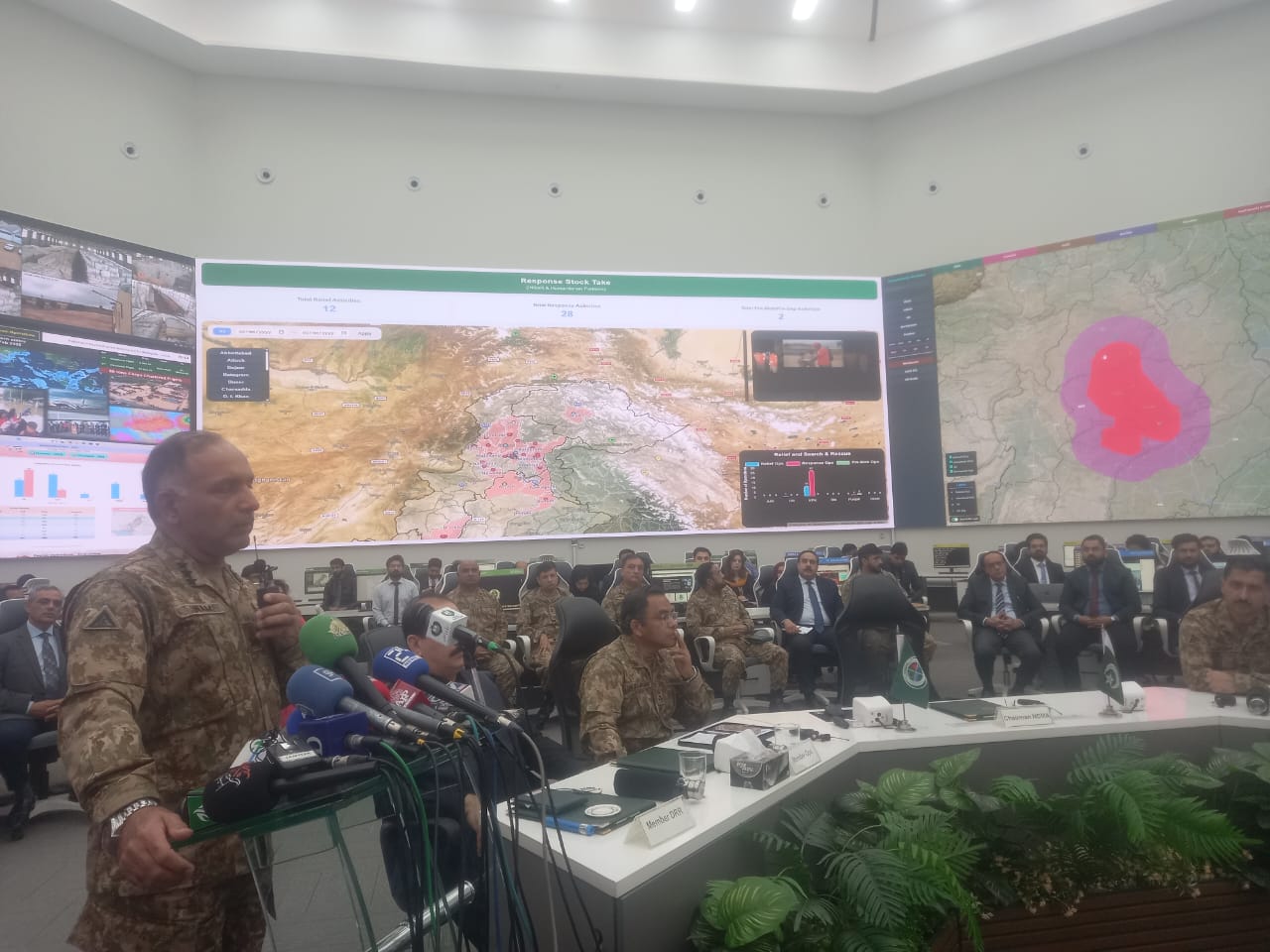 A rain-producing system has also entered the Koh-e-Sulaiman region, under whose influence moderate rains are also expected in Rajanpur, Muzaffargarh, DI Khan and Tank region. He said that moderate rains are also expected in the areas of Barkhan, Awsta and Kohlu region and Awaran in Balochistan. He said that as per the instructions of Prime Minister Muhammad Shahbaz Sharif and Chairman NDMA, NDMA officials are present in all areas to help Pakistani sisters and brothers in the rains and flood-affected areas and all efforts are being made for relief, which includes all other relief and rehabilitation agencies. On this occasion, Sarah Hassan, while giving details of the water flow in the rivers, said that the current system that is causing rains is not only the eastern but also the western system. She said that the current water flow in the Kabul River is 54 thousand cusecs, but due to heavy rains during the next 24 to 48 hours, the water flow may increase to 80 thousand cusecs, which will be a medium flood.
A rain-producing system has also entered the Koh-e-Sulaiman region, under whose influence moderate rains are also expected in Rajanpur, Muzaffargarh, DI Khan and Tank region. He said that moderate rains are also expected in the areas of Barkhan, Awsta and Kohlu region and Awaran in Balochistan. He said that as per the instructions of Prime Minister Muhammad Shahbaz Sharif and Chairman NDMA, NDMA officials are present in all areas to help Pakistani sisters and brothers in the rains and flood-affected areas and all efforts are being made for relief, which includes all other relief and rehabilitation agencies. On this occasion, Sarah Hassan, while giving details of the water flow in the rivers, said that the current system that is causing rains is not only the eastern but also the western system. She said that the current water flow in the Kabul River is 54 thousand cusecs, but due to heavy rains during the next 24 to 48 hours, the water flow may increase to 80 thousand cusecs, which will be a medium flood.
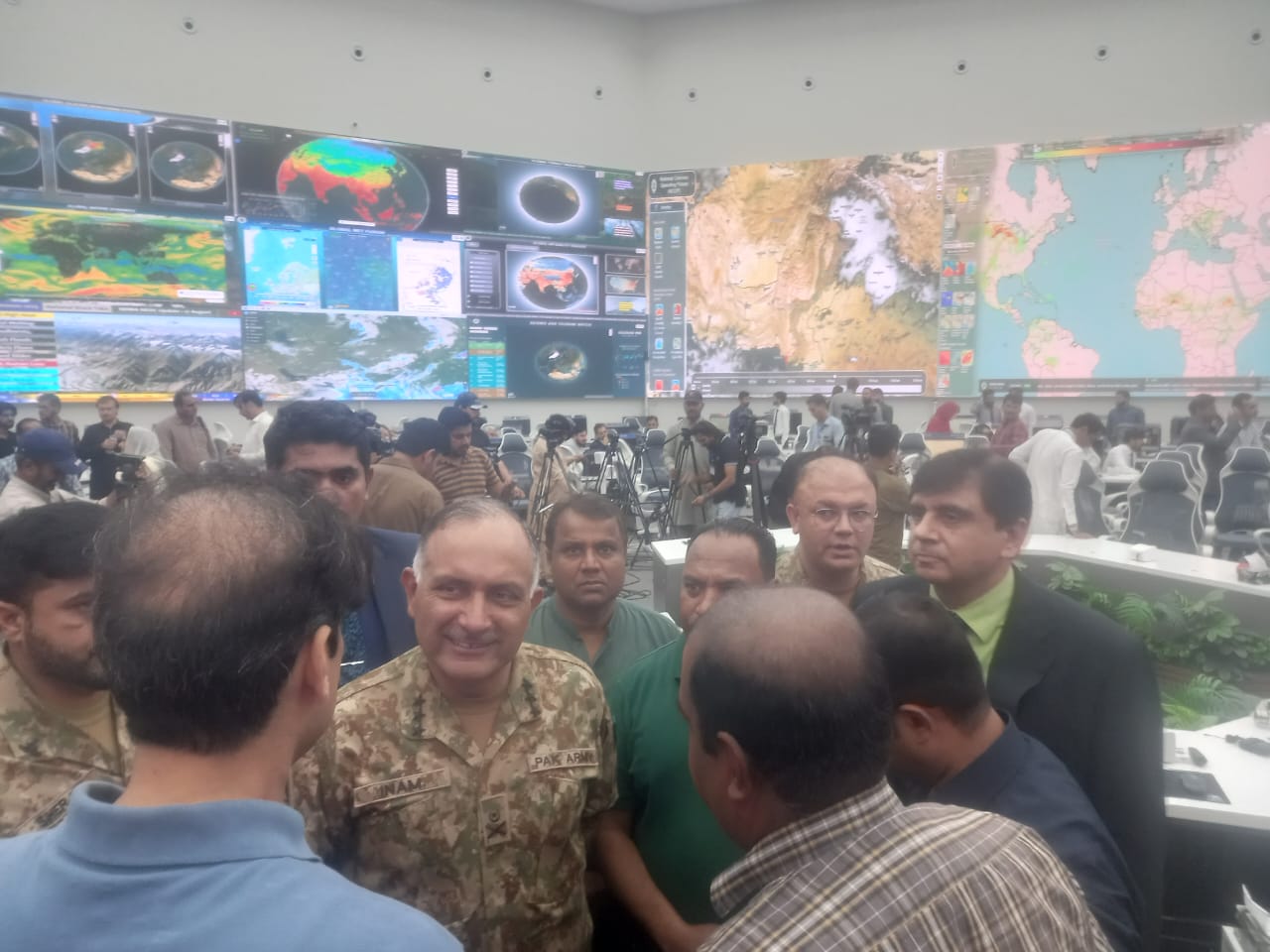 Regarding the Indus River, he said that the current water storage in the Tarbela Dam has reached 98% of the dam’s capacity, but due to rains, the water flow may increase by 4 to 4.5 lakh cusecs, which reflects a medium-level flood. The situation is currently moderate in the Indus River downstream of Tarbela at Kalabagh, Chashma and Taunsa and there is a water flow of 4 to 4.5 lakh cusecs at these places, but due to heavy rains in the next 24 to 48 hours, the water flow at these places may increase to 5 to 5.5 lakh cusecs, which may cause high-level flooding.Regarding the situation of rivers in the eastern region of the country, he said about the Chenab River that due to heavy rains in illegally occupied Jammu and Kashmir and Himachal Pradesh, the water flow at Khanki and Marala places may increase to 150,000 cusecs, i.e. medium flood. Similarly, regarding the monitoring of Indian dams, he said that we are closely monitoring Indian dams and there is low level flood in the river entering Pakistan from Ganda Singh and the water flow is 54,000 cusecs, but in the next one to two days, the water flow is likely to increase to 80,000 to 95,000 cusecs, which will be a medium flood situation. Sarah Hassan said about urban flooding and rain emergency that more than 70 mm of rain has been recorded in Islamabad during the last 24 hours, due to which the water level in Katarian and Gowalmandi has risen to 14 feet, an urban flooding alert is issued at 15 feet. Due to more rains, there is a risk of urban flooding and rain emergency in Islamabad, Rawalpindi, Lahore, Faisalabad, Gujrat and other districts. Similarly, there may be a risk of mountain flooding in the southern region of Punjab, adjacent to Koh Sulaiman, DG Khan and Rajanpur districts. Regarding the southern region of the country, 40 mm of rain has fallen in Tharparkar in the last 24 hours.
Regarding the Indus River, he said that the current water storage in the Tarbela Dam has reached 98% of the dam’s capacity, but due to rains, the water flow may increase by 4 to 4.5 lakh cusecs, which reflects a medium-level flood. The situation is currently moderate in the Indus River downstream of Tarbela at Kalabagh, Chashma and Taunsa and there is a water flow of 4 to 4.5 lakh cusecs at these places, but due to heavy rains in the next 24 to 48 hours, the water flow at these places may increase to 5 to 5.5 lakh cusecs, which may cause high-level flooding.Regarding the situation of rivers in the eastern region of the country, he said about the Chenab River that due to heavy rains in illegally occupied Jammu and Kashmir and Himachal Pradesh, the water flow at Khanki and Marala places may increase to 150,000 cusecs, i.e. medium flood. Similarly, regarding the monitoring of Indian dams, he said that we are closely monitoring Indian dams and there is low level flood in the river entering Pakistan from Ganda Singh and the water flow is 54,000 cusecs, but in the next one to two days, the water flow is likely to increase to 80,000 to 95,000 cusecs, which will be a medium flood situation. Sarah Hassan said about urban flooding and rain emergency that more than 70 mm of rain has been recorded in Islamabad during the last 24 hours, due to which the water level in Katarian and Gowalmandi has risen to 14 feet, an urban flooding alert is issued at 15 feet. Due to more rains, there is a risk of urban flooding and rain emergency in Islamabad, Rawalpindi, Lahore, Faisalabad, Gujrat and other districts. Similarly, there may be a risk of mountain flooding in the southern region of Punjab, adjacent to Koh Sulaiman, DG Khan and Rajanpur districts. Regarding the southern region of the country, 40 mm of rain has fallen in Tharparkar in the last 24 hours.
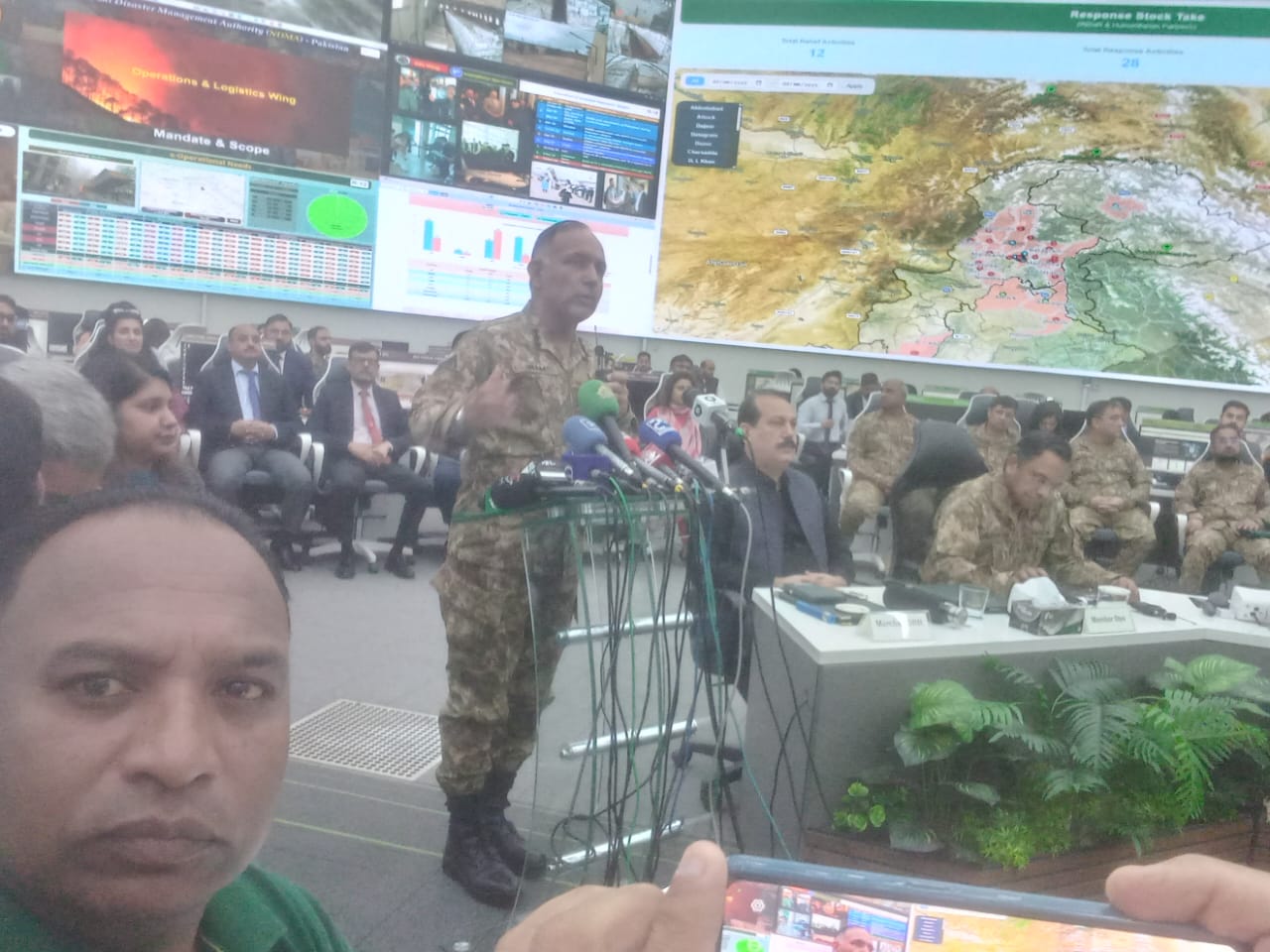 Further increase in rains may increase the chances of urban flooding in other districts including Badin, Sujawal. Regarding the northern regions of the country and Azad Kashmir, she said that the chances of flash flooding and landslides may increase in the districts of Neelum, Poonch and Bagh in Kashmir. Regarding the Gilgit-Baltistan region, Sarah Hassan said that some accidents have also taken place in this area in the past few days, including the risk of further landslides and flash flooding in the districts of Ganchhe, Skardu and Gilgit etc. She said that the chances of the Shaspar glacier erupting in the Gulf may also increase. Similarly, local and flash flooding may also occur in the districts of Chitral, Dir, Swat, Buner, Shangla, as well as Peshawar and Charsadda in Khyber Pakhtunkhwa.Various areas of Buner have been more affected by the previous rains and there is a risk of flash flooding in the northern areas due to further rains. Referring to the responsibilities and scope of the Operation Wing at the federal level, Brigadier Kamran, Member Operations and Logistics of NDMA, said that we had started preparing for the monsoon from February 2025, for which we have organized various conferences and other activities in collaboration with all the provincial governments and PDMAs, issued a monsoon preparedness plan at the national level, while since June 25, we have started regular monitoring of weather conditions and regular planning has been made at the district level regarding relief and rehabilitation activities in any emergency situation, and we have also facilitated the assistance of FC and other law enforcement agencies in the form of federal assistance in any emergency situation in any district so that rescue operations can be assisted. The seventh spell of rains is ongoing while the eighth spell is expected to start soon, most of the effects of which were seen in northern Khyber Pakhtunkhwa and southern Punjab.
Further increase in rains may increase the chances of urban flooding in other districts including Badin, Sujawal. Regarding the northern regions of the country and Azad Kashmir, she said that the chances of flash flooding and landslides may increase in the districts of Neelum, Poonch and Bagh in Kashmir. Regarding the Gilgit-Baltistan region, Sarah Hassan said that some accidents have also taken place in this area in the past few days, including the risk of further landslides and flash flooding in the districts of Ganchhe, Skardu and Gilgit etc. She said that the chances of the Shaspar glacier erupting in the Gulf may also increase. Similarly, local and flash flooding may also occur in the districts of Chitral, Dir, Swat, Buner, Shangla, as well as Peshawar and Charsadda in Khyber Pakhtunkhwa.Various areas of Buner have been more affected by the previous rains and there is a risk of flash flooding in the northern areas due to further rains. Referring to the responsibilities and scope of the Operation Wing at the federal level, Brigadier Kamran, Member Operations and Logistics of NDMA, said that we had started preparing for the monsoon from February 2025, for which we have organized various conferences and other activities in collaboration with all the provincial governments and PDMAs, issued a monsoon preparedness plan at the national level, while since June 25, we have started regular monitoring of weather conditions and regular planning has been made at the district level regarding relief and rehabilitation activities in any emergency situation, and we have also facilitated the assistance of FC and other law enforcement agencies in the form of federal assistance in any emergency situation in any district so that rescue operations can be assisted. The seventh spell of rains is ongoing while the eighth spell is expected to start soon, most of the effects of which were seen in northern Khyber Pakhtunkhwa and southern Punjab.
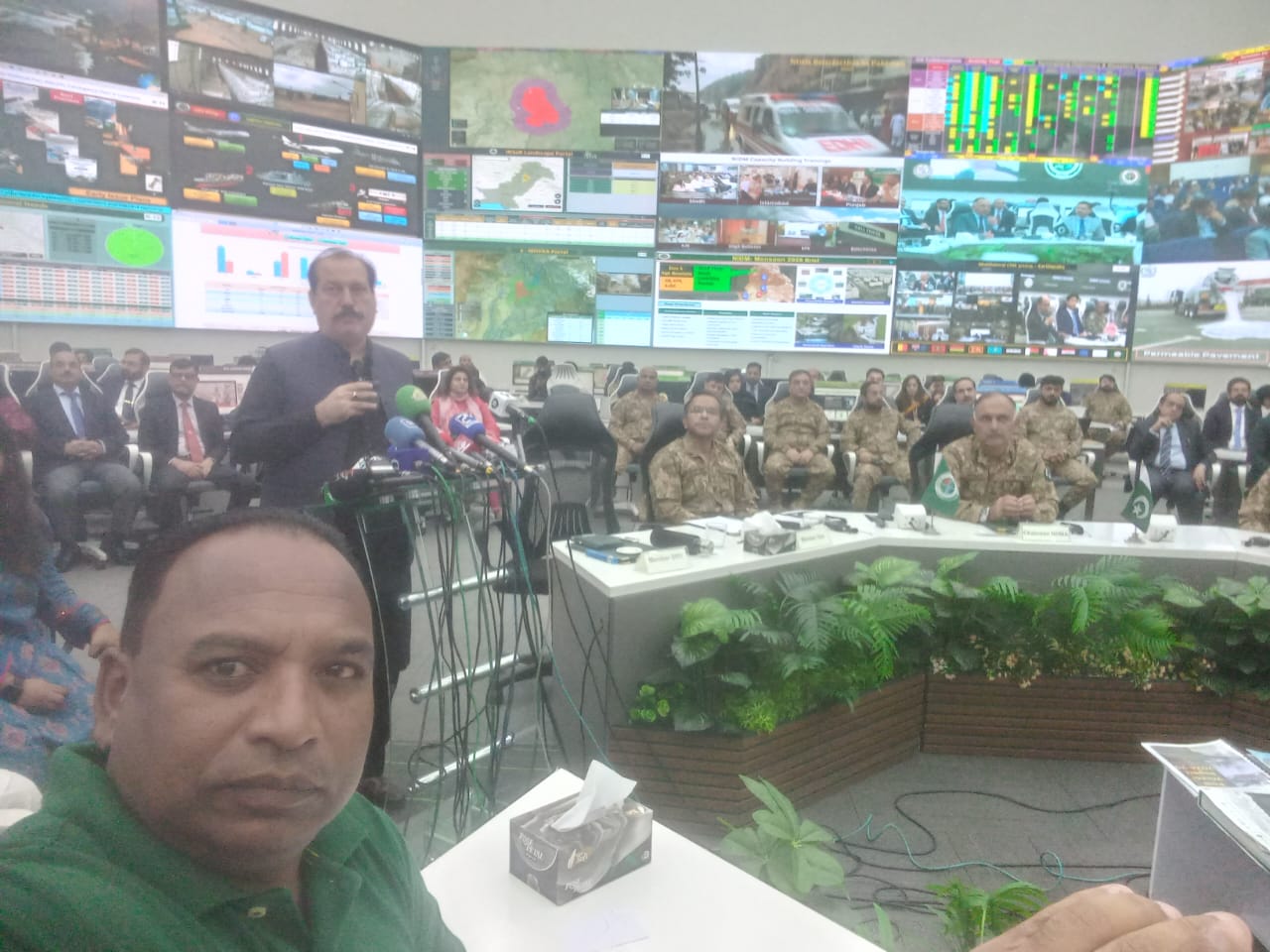 During this time, wherever the provincial government needed our help in various incidents, we coordinated with them through helicopters, army and navy and air force to help them. He said that the PDMAs share monitoring reports with us on a daily basis, which are compiled and issued at the national level. Regarding the recent rains and floods, he said that the most problems were caused by sudden cloudbursts in Buner and Bajaur. In this regard, an early warning was issued while preparations were also made, but due to the sudden disaster, losses were faced. So far, 300 deaths and 156 injuries have been reported. While giving details of the relief operation for the displaced people in these areas, Brigadier Kamran said that all possible assistance and assistance is being provided at the district, provincial and federal levels and the country’s welfare institutions are also playing their respective roles in this regard. Regarding the details of the assistance from federal institutions, he said that the Pakistan Army immediately mobilized the resources available in the area, due to which the Frontier Corps North was immediately mobilized to help the district and provincial administration. Coordination was done with the Pakistan Army regarding further assistance in relief activities and other teams including two army battalions and a company of Engineer Corps from Punjab were sent to Buner and Shangla. He said that unfortunately, Khyber Pakhtunkhwa’s own helicopter crashed, the provincial government was provided with the assistance of army helicopters, now rehabilitation measures are being taken in the area, rations, beds and other necessary items have been provided to the victims as part of immediate assistance. The Prime Minister said that the federal government has provided immediate relief items to KPK and a second package will also be sent on Monday, the supply of relief items will continue so that the people of the affected areas can be helped immediately. He said that the rehabilitation operation is underway, which is being monitored regularly and wherever the need for federal assistance arises, it is provided. During the briefing, NDM officials said that the authority is also in touch with local and international NGOs regarding relief activities. He said that in the current situation, we responded immediately, contacted all welfare institutions, NGOs and INGOs and informed them about the situation, for which relief activities were highlighted on the portals on an emergency basis and also informed them about the details of the relief activities.
During this time, wherever the provincial government needed our help in various incidents, we coordinated with them through helicopters, army and navy and air force to help them. He said that the PDMAs share monitoring reports with us on a daily basis, which are compiled and issued at the national level. Regarding the recent rains and floods, he said that the most problems were caused by sudden cloudbursts in Buner and Bajaur. In this regard, an early warning was issued while preparations were also made, but due to the sudden disaster, losses were faced. So far, 300 deaths and 156 injuries have been reported. While giving details of the relief operation for the displaced people in these areas, Brigadier Kamran said that all possible assistance and assistance is being provided at the district, provincial and federal levels and the country’s welfare institutions are also playing their respective roles in this regard. Regarding the details of the assistance from federal institutions, he said that the Pakistan Army immediately mobilized the resources available in the area, due to which the Frontier Corps North was immediately mobilized to help the district and provincial administration. Coordination was done with the Pakistan Army regarding further assistance in relief activities and other teams including two army battalions and a company of Engineer Corps from Punjab were sent to Buner and Shangla. He said that unfortunately, Khyber Pakhtunkhwa’s own helicopter crashed, the provincial government was provided with the assistance of army helicopters, now rehabilitation measures are being taken in the area, rations, beds and other necessary items have been provided to the victims as part of immediate assistance. The Prime Minister said that the federal government has provided immediate relief items to KPK and a second package will also be sent on Monday, the supply of relief items will continue so that the people of the affected areas can be helped immediately. He said that the rehabilitation operation is underway, which is being monitored regularly and wherever the need for federal assistance arises, it is provided. During the briefing, NDM officials said that the authority is also in touch with local and international NGOs regarding relief activities. He said that in the current situation, we responded immediately, contacted all welfare institutions, NGOs and INGOs and informed them about the situation, for which relief activities were highlighted on the portals on an emergency basis and also informed them about the details of the relief activities.
 He also informed the NGOs in the affected areas about the needs of relief activities. Welfare institutions and NGOs ensured immediate provision of relief materials in the affected areas. He said that assistance is also provided in cooperation with local, provincial institutions and security agencies to deliver the relief materials provided by the NGOs to the victims. He said that the details issued by the Tech Wing of NDMA are immediately shared with the relevant institutions so that welfare institutions and NGOs in the relevant areas can be mobilized in a timely manner. It is important to note that rescue operations are underway by the Pakistan Army in different areas of Buner, and military forces are also participating in rescue operations in village Churak. People buried under the rubble of destroyed houses in Adam Khel are also being rescued. The supply of ration and bedding to the affected families is also ongoing. The Pakistan Army is playing its full role to help the people in the flood-affected districts.
He also informed the NGOs in the affected areas about the needs of relief activities. Welfare institutions and NGOs ensured immediate provision of relief materials in the affected areas. He said that assistance is also provided in cooperation with local, provincial institutions and security agencies to deliver the relief materials provided by the NGOs to the victims. He said that the details issued by the Tech Wing of NDMA are immediately shared with the relevant institutions so that welfare institutions and NGOs in the relevant areas can be mobilized in a timely manner. It is important to note that rescue operations are underway by the Pakistan Army in different areas of Buner, and military forces are also participating in rescue operations in village Churak. People buried under the rubble of destroyed houses in Adam Khel are also being rescued. The supply of ration and bedding to the affected families is also ongoing. The Pakistan Army is playing its full role to help the people in the flood-affected districts.
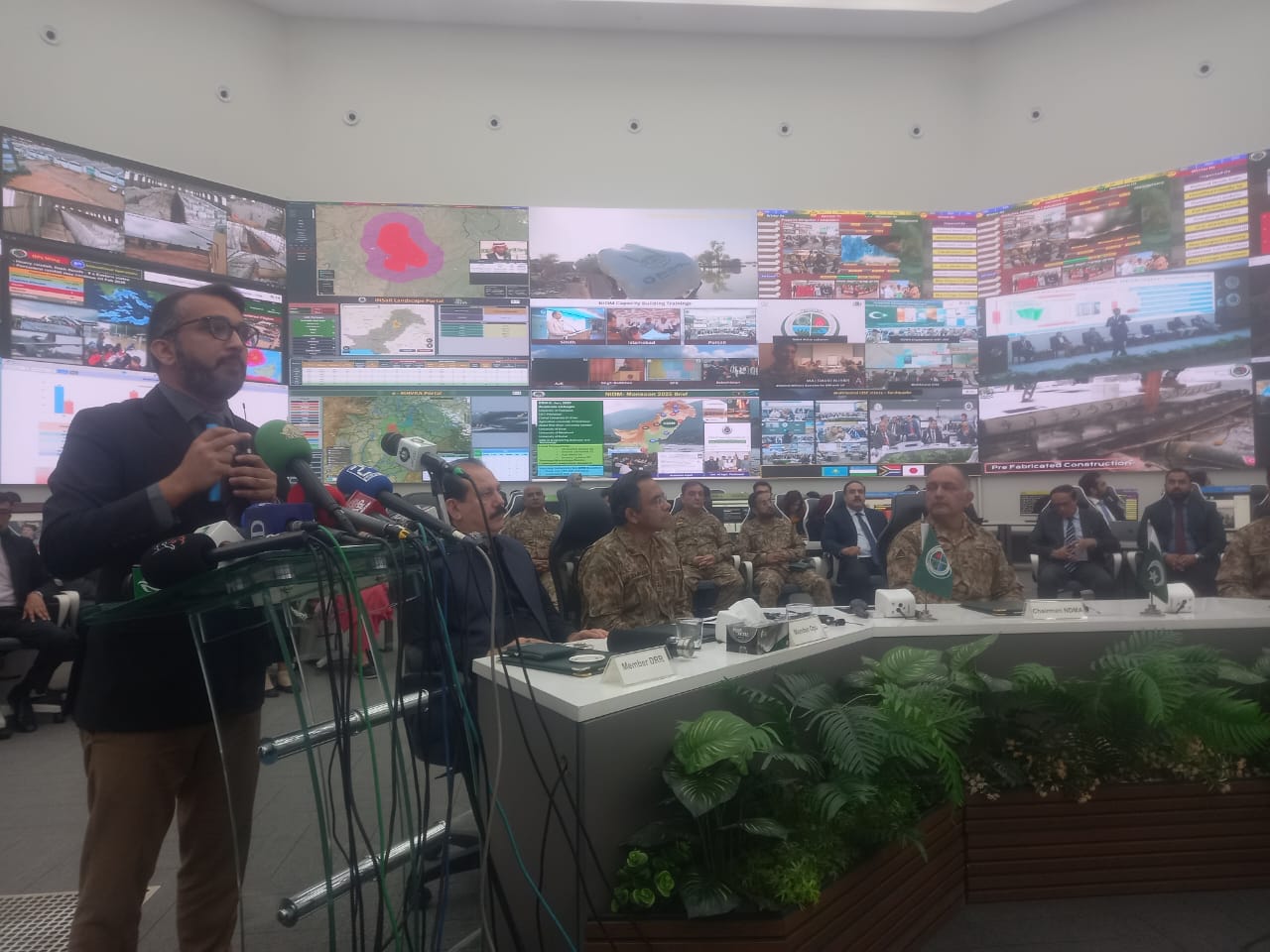 Despite the bad weather, Pakistan Army helicopters are participating in rescue and relief activities. Citizens expressed satisfaction with the relief work and thanked the Pakistan Army. Meanwhile, the district administration of Buner district of Khyber Pakhtunkhwa has reported in the report of the flood-affected areas that the number of deaths due to cloudburst and floods has exceeded 400. According to the Deputy Commissioner of Buner, the devastating floods have caused widespread destruction in Buner district, resulting in 401 deaths and 671 injuries. So far, 401 deaths, 671 injuries and loss of 4,054 livestock have been confirmed due to the disaster. 2,300 houses were completely destroyed, while 413 houses were partially damaged. The educational infrastructure was also severely affected.
Despite the bad weather, Pakistan Army helicopters are participating in rescue and relief activities. Citizens expressed satisfaction with the relief work and thanked the Pakistan Army. Meanwhile, the district administration of Buner district of Khyber Pakhtunkhwa has reported in the report of the flood-affected areas that the number of deaths due to cloudburst and floods has exceeded 400. According to the Deputy Commissioner of Buner, the devastating floods have caused widespread destruction in Buner district, resulting in 401 deaths and 671 injuries. So far, 401 deaths, 671 injuries and loss of 4,054 livestock have been confirmed due to the disaster. 2,300 houses were completely destroyed, while 413 houses were partially damaged. The educational infrastructure was also severely affected.







